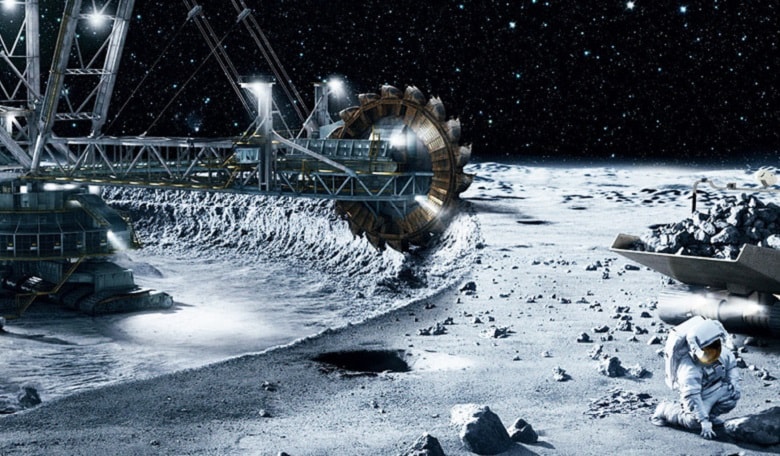Today, many would be startled to learn, there are four United States-based companies whose business plans involve ‘space mining’ for profit. These companies include Planetary Resources Inc, Deep Space Industries, Moon Express, and Shackleton Energy Corporation. There is a great abundance of wealth of natural resources on our six sextillion ton planet. But we humans, now numbering some 7.5 billion and likely to grow as large as 12 billion by 2100, have a vast hunger for products and energy. With our automated manufacturing machines we have developed to ability to manufacture a relentless army of goods and we consume more and more energy every year.
If all of the natural resources on our planet are used wisely and in a sustainable fashion they can be recycled and used over and over again. Modern civilization, with its complex infrastructure, burgeoning population and surging urban complexes will soon need to adjust to emerging 21st century realities. By the end of this century there may be perhaps a 100 megacities of more than 10 million people. Our world will be experiencing significant elements of climate change, major environmental shifts, and growing natural resource needs. The world as we know it today will significantly change or, life as we know it today, will no longer be sustainable.
In short big changes are coming. We will be forced to shift to sustainable and renewable energy sources. We will be forced to engage in more and more recycling. We will have to change our ways of life as our cities absorb more than 70 per cent of the world’s population. We will, despite all these shifts, still need to reach out into space and start to evolve a space-based economy.
US Secretary of State John Hay once famously said: “The Mediterranean is the ocean of the past, the Atlantic is the ocean of the present, and the Pacific is the ocean of the future.” And over time the global economy has expanded to make this prediction a reality. Soon the economies of China, India, Indonesia and Japan - plus the smaller countries of Singapore, Taiwan, Republic of Korea, Thailand, etc - will outstrip those of the US and Europe.
Space technology grows more amazing every day and the ambitions of new private space entrepreneurs just keep growing in leaps and bounds
As these developing economies get more prosperous and demand for natural resources continues to grow, the availability of natural resources will become a growing problem. In considering the future, one might do well to consider Ray Kurzweil and his prediction about the coming ‘Singularity’ or those of Peter Diamandis in forecasting a future that is increasingly based on an extra-terrestrial and space-based economy. The value of platinum-rich asteroids have been estimated at levels ranging from US$200 billion up to even a trillion dollars. Of course the future of our energy needs rest with the Sun.
Space-based industries and mining
The future is most often viewed through a rear view window. And for millions of years of biological evolution the past was indeed often a prologue to the future. With the advent of technology, computer and communications networks, artificial intelligence, robotics and the ability to go into space, the rate of change in human civilization has increased exponentially.
The ‘Super Month’ graphic compresses time since the age of the Southern Ape Man into a 30 day period where every second represents two years. In Super Month time the age of farming and permanent settlements represents the last hour and a half of the last day of the month, the renaissance is the last four minutes, and the industrial age is two minutes until midnight. The age of computers, cell phones, television, bio-engineering, megacities, space launches and spandex - all the elements of modern life we take for granted - represent only the last 20 seconds of Super Month time.
This graphic serves to demonstrate that judging future societal needs on past experience is a seriously flawed concept. The future needs of human civilization in terms of energy, housing, transportation, water, natural resources, jobs and employment and security are dramatically different than they were ever before. As an illustrative example, it has been artfully noted that it would be far easier for Moses to come and live in the times of Napoleon and Thomas Jefferson, than for someone living in the 18th century to come forward and live in today’s world of advanced technology.
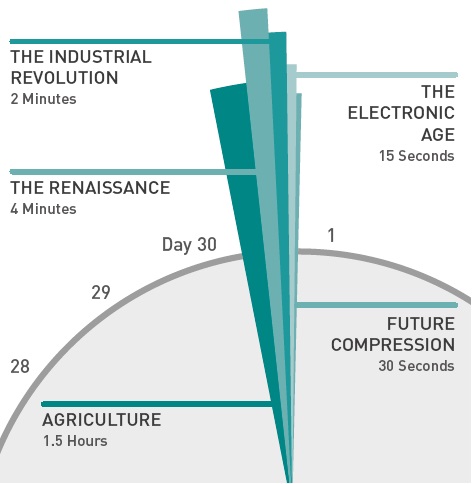 TThe Super Month that represents the entire time since the advent of the Southern Ape Man shows every almost “everything” has happened in the last tiny bit of Super Month time.
TThe Super Month that represents the entire time since the advent of the Southern Ape Man shows every almost “everything” has happened in the last tiny bit of Super Month time.
When Peter Diamandis talks of abundance and Ray Kurzweil of singularity, they are suggesting a world that is far different than we ever experienced before. They envision a world which we cohabitate with robots that are as smart as humans and possess sophisticated ‘thinking’ skills, space probes that can be used to bring us new resources and clean energy from space and also protect our critical infrastructure from cosmic hazards.
Scale and complexity
The land area of the entire world is 148.94 million sq km (57.506 million sq miles) and its water area is 361.132 million sq km (or 139.434 million sq miles). About half of that land area is truly viable for year round habitation when one eliminates most parts of Antarctica, the Arctic north, Siberia, the most severe mountain ranges and the most arid desert regions. Rising sea levels will, however, further decrease available land areas.
When one divides about 75 million sq km by 10 billion people (or about 133 people/sq km) it becomes clear that rising global population and shrinking land areas along with the exhaustion of many types of natural resources - especially potable water - will be a growing problem. The accompanying graphic shows the volume of potable water in the world in comparison to the volume of Earth, helping us realise just how small the amount of potable water that is truly accessible today in comparison to a rising global population actually is.
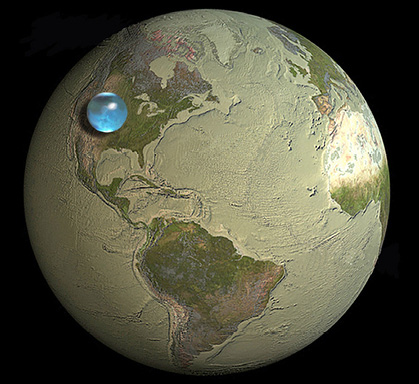 The volume of Earth’s water in comparison to the volume of the world
The volume of Earth’s water in comparison to the volume of the world
It underscores the issue of just how difficult it will be to continue to provide key resources especially to major urban centres as global population continues to grow. And this is not just a question of sustaining human needs for water and natural resources; it is also a matter of sustaining endangered species of flora and fauna.
They envision a world which we cohabitate with robots that are as smart as humans and possess sophisticated ‘thinking’ skills
The future availability of petroleum products and water is most often mentioned in studies of future resource scarcity but broader studies have shown that the world by the mid-21st century will have many shortages.
Results from a detailed Global Non-renewal Natural Resources (NNR) Study show an overall trend toward increasing shortages. The upward mobility of the populations in China, India, Indonesia, and other newly industrialised countries suggests that up to three times more consumer demand for products and energy will be present by the middle of the 21st century. Only recycling and new energy sources can meet the great bulk of this burgeoning demand. Meeting the demand for natural resources has been identified as an issue by many that have researched this problem. The projections of shortages in the future are presented in the ‘resources chart’.
Yet the prospect of space mining can provide new options. A modest near-Earth asteroid high in platinum content and approximately spherical in shape and 30 m in diameter would constitute a volume of 4,500 cubic m and represent a mass of perhaps 5,000 tonnes. If one assumed that this asteroid was 50 per cent platinum then its value at current world market prices would be on the order of US$90 billion. Even if the asteroid recovery mission and refinement costs ran to US$5 billion and even if some of the proceeds were to go into some sort of global commons development or ecological fund, just a single such mission would produce many billions of dollars in profits. This may represent an extreme example, but there are over a million potentially hazardous asteroids (PHA) that are on the order of 30 m in diameter and orbit in close proximity to Earth. The key in the early days of space mining would be to identify high value targets.
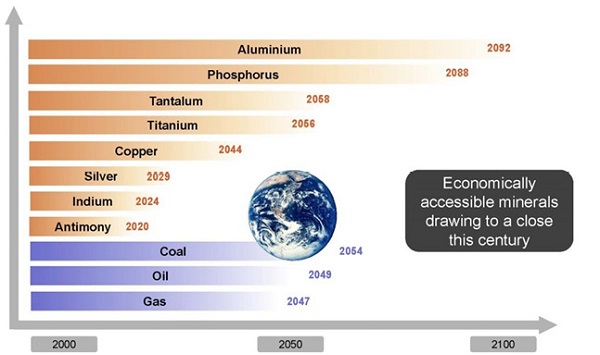 Projected shortages of economically accessible minerals
Projected shortages of economically accessible minerals
A 50 m PHA would be over 4.6 times more massive in volume and content and would be incredibly valuable if it contained precious metals or rare Earth materials such as Iridium, Rhodium, Ruthenium, Palladium or Osmium.
In contrast, the economics would be much more difficult in the case of PHAs with less valuable natural resource contents. An asteroid with 70 per cent Nickel and Molybdenum content and 50 m in diameter would have something like a market value of only about US$200 million based on current market prices of US$13,000 a tonne for Molybdenum and US$10,000 a tonne for Nickel. This much lower valuation would imply space mining transport equipment of the longer term future that could be used over and over again. It would also likely imply systems that ran off of solar and electric propulsion systems.
It is important to note that space mining activities can be cost-effective for recovering at least rare metals, but it is also noteworthy that even hydrogen, oxygen, water or other volatiles in space can also be valuable. The Planetary Resources website states, ‘In orbit, spacecraft propellant is a multi-billion dollar industry with each pound of fuel worth more than an equivalent pound of gold on Earth. Certain asteroids are loaded with hydrogen and oxygen, the components of rocket fuel. These asteroids can provide a fuel source that is 100 times closer ‘energetically’ to Earth orbit, and thus far less expensive, than the Apollo era bring-everything-with-you propellant used today.’
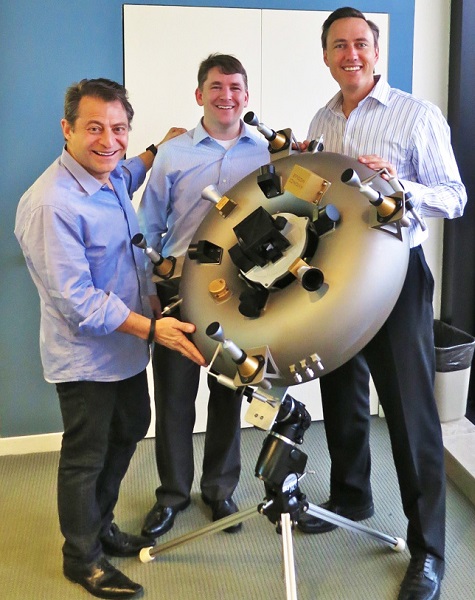 Peter Diamandis, Chris Lewicki and Steve Jurvetson of Planetary Resources unveiling their 3D Printed satellite in February 2014
Peter Diamandis, Chris Lewicki and Steve Jurvetson of Planetary Resources unveiling their 3D Printed satellite in February 2014
But the space mining industry can also aid in producing and perfecting new technologies that could assist with other types of space missions, or produce innovations that can find useful implementation right here on Earth. Space mining activities will be seeking to develop new and more cost-effective robotics missions, advanced navigation and precision manoeuvring in space, improved space situational systems, lower cost satellite manufacturing techniques and improved power systems including higher efficiency photovoltaic cells and quantum dot technology.
There are a number of efforts underway to seek to clarify the future prospects for space mining activities
Of course, the most important contribution could well be more cost-effective space transportation systems such as solar powered electric propulsion. If one could develop multi-use systems that can be used over and over again this could also be used to deploy solar power satellites.
Likewise, if space mining enterprises can develop low cost satellites that could be produced at lower cost and in high volume via 3D printing this could be quite significant. Such techniques could also find application in communications, precision satellite navigation, and remote sensing constellations and on other space missions.
Clearly low cost remote surveying and reconnaissance satellites are currently a top priority for space mining ventures and Planetary Resources, together with 3D Systems, is currently developing a prototype small satellite. This Arkyd satellite bus configuration uses its efficient torus shape to hold the propellant and also provide the structure for the satellite. The fact that the satellite can be ‘manufactured’ via 3D printing greatly reduces its manufacturing cost. One characteristic of the new space mining companies is that they have typically recruited partners to help them develop these new types of technology. They have also been skilfull in winning contracts from NASA for research and development work.
Legal and regulatory problems
The current state of the incipient space mining industry is that it has been far more adept at identifying the scientific, engineering and technological challenges to be faced and pursuing systems solutions than it has at addressing what might be called the legal, regulatory and standards problems that this new type of enterprise entails.
The only established international law that has widespread acceptance is the Outer Space Treaty (OST). The so-called Moon Treaty has only a few signatories and has not been ratified by many space powers. Other provisions such as the Liability Convention are also relevant, as well as various efforts to define provisions regarding the use of nuclear systems in space. The most relevant parts of the OST are Articles I and II.
Article I
‘The exploration and use of outer space, including the moon and other celestial bodies, shall be carried out for the benefit and in the interests of all countries, irrespective of their degree of economic or scientific development, and shall be the province of all mankind.
Outer space, including the moon and other celestial bodies, shall be free for exploration and use by all States without discrimination of any kind, on a basis of equality and in accordance with international law, and there shall be free access to all areas of celestial bodies.
There shall be freedom of scientific investigation in outer space, including the moon and other celestial bodies, and States shall facilitate and encourage international co-operation in such investigation.’
Article II
‘Outer space, including the moon and other celestial bodies, is not subject to national appropriation by claim of sovereignty, by means of use or occupation, or by any other means.’
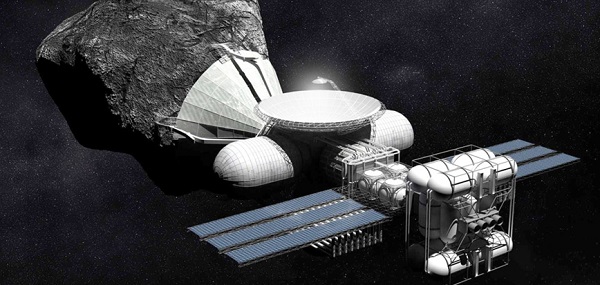 Mining an asteroid
Mining an asteroid
Despite these provisions there are at least four private entities seeking to engage in space mining activities. One of the key question is exactly what the definition of a celestial body is and to what extent a small asteroid of which there are millions constitute a celestial body. Clearly such asteroid mining of small and potentially hazardous bodies would seem much more permissible under the Outer Space Treaty than efforts to establish national or private colonies on the Moon or to undertake mining operations on the Moon.
Up to three times more consumer demand for products and energy will be present by the middle of the 21st century
There are a number of efforts underway to seek to clarify the future prospects for space mining activities - whether they might be national or private ventures - and to address the future legal and regulatory status of such undertakings. These efforts include the McGill University Air and Space Law Institute ‘Global Space Governance Study’ that devotes a chapter to this topic. From a practical rather than a legal viewpoint it would seem that the projects by Planetary Resources Inc and Deep Space Industries seem to have less of a legal, regulatory or standards challenge to their proposed efforts than Shackleton Energy and Moon Exporess, which are focused on mining on the Moon.
Planetary Resources’ mission statement asserts that inhabitants of Earth are currently limited to the finite resources found on our planet but that we do not have to be limited to this fate over the longer term future.
There indeed may be a need to create structures in space to defend our planet against extreme solar storms, and new types of space infrastructure to provide new forms of clean energy down to the ground. The future is clearly not what it used to be. New space industries could indeed change our future - perhaps for the better or perhaps for worse. The future compression that is bringing future realities to the fore at an ever more rapid pace in Super Month Time will require institutional and legal responses to these new types of space initiatives in an ever more rapid way.





